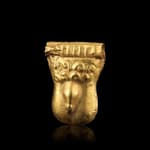Graeco-Roman
Provenance
Louis De Clercq (1836 – 1901) Collection, Oignies, France, acquired from the above by 1882
Thence by descent to his grand-nephew Comte Henri de Boisgelin (1901 – 1967), rue de Mazarine, Paris
Literature
Such amulets were worn to ward off evil and promote good luck. They invoked the power of the fascinus, the sacred image of the phallus that was one of the tokens of the safety of the Roman state. Fascinus was thought particularly to ward off evil from children, mainly boys, and from conquering generals. The protective function of the phallus is usually related to the virile and regenerative powers of an erect phallus, though in most cases the emotion, shame, or laughter created by obscenity is the power that diverts the evil eye.
Pliny calls it a medicus invidiae, a ‘doctor’ or remedy for envy (invidia "looking upon") or the evil eye. The wearing of a phallus amulet round the neck and its apotropaic function is clearly indicated by Varro, (de lingua Latina, vii, 97) it is worn by boys, ‘to prevent harm from coming to them'.
For a similar example in the British Museum see acc. no. 1814,0704.1177. For further and discussion see C. Johns, Sex or Symbol?, Erotic Images of Greece and Rome, London, 1982, pp. 63-66, pl. 10.



